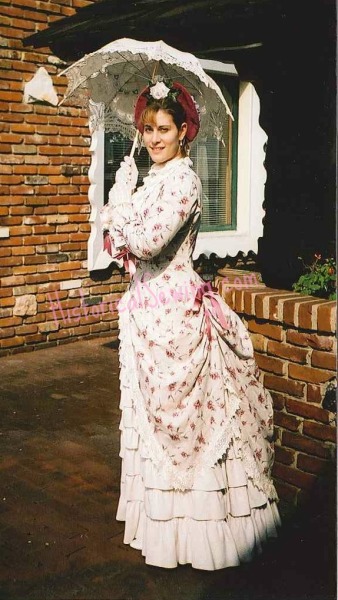
Do you remember your first true historical costume? Did you like it?
My first Victorian gown was made specifically for the first Costume College year I attended (in 2000) for the Sunday Fantasy Tea that year.
Since I had been making my own clothes from the time I was in junior high (mid-1980s) I knew I had decent skills to tackle a Victorian project. Being in love with ruffles I was determined to complete the uber-popular 1880s Polonaise and Walking Skirt from Past Patterns.
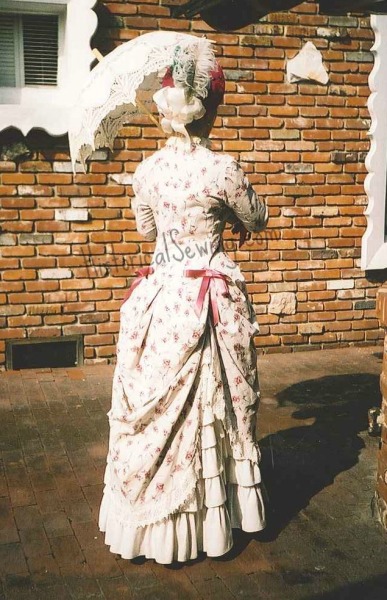
Prior to making the dress, I successfully made my first set of undergarments (chemise & drawers) as well as a corset earlier that year with the help of new friend who later became a mentor as I pursued the depths of historical costuming.
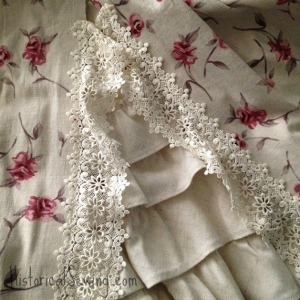
At the time I don’t think I had yet experienced the fantasyland that is the Downtown Los Angeles Garment District so went shopping where I worked – JoAnn Fabrics. The store yielded a beautiful linen/cotton blend in a natural linen color with a printed rose design which I fell in love with immediately. (I really wish I had more of it.) For the ruffles I decided on a linen/poly blend that matched.
As I was putting the dress together I DID get the opportunity to visit Downtown… and my jaw hit the floor when I could purchase the gorgeous 2.5″ lace for only $2/yard. I also got a yard of China silk for the pleated neckline fill-in.
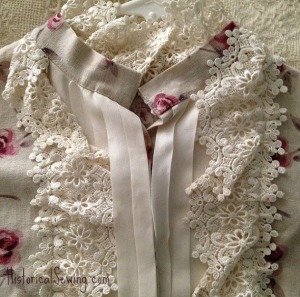

The dress was easy enough to make. And yes, I did machine hem all ten rows of bias cut ruffles. Whoa! THAT was a learning experience! They are all sewn to a basic, unbleached muslin base.
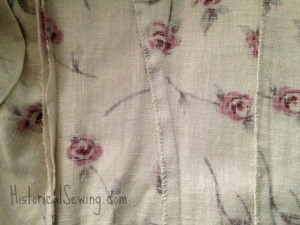
Not wanting to pink the raw edges or use my serger, I started to hand whipstitch them for finishing. I only got a couple seams done before the event and it still hangs that way in my closet today.
Because this was my first dress I didn’t have boning in any seam, nor did I flatline any part of the bodice for stability – two things that have become basic steps in my Victorian gowns today.
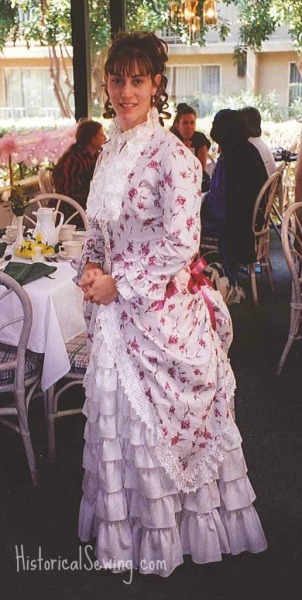
I LOVE this dress! Not only is it my first Victorian gown where I started dressing up to bring the past to life, but simply because it’s romantic! Ruffles and lace and roses – oh yes!
That year at Costume College, and the ones after, I learned a great deal about how to make the dress better:
- I really need a hat as this is a day dress. So later I made one from scratch with buckram, wire and raspberry velveteen. 🙂
- This pattern looks better over a lobster tail bustle support even though the instructions say it can be worn alone. (I will also put in that you need at least one petticoat too!!)
- Even with a heavy linen/cotton fabric, being Victorian it still should have been flatlined with muslin and boned. Of course.
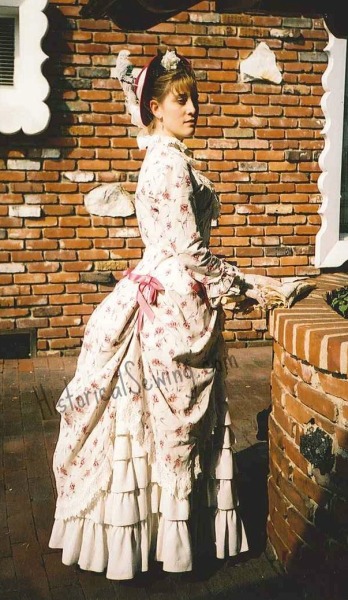
What was your first Victorian gown?


I attended a free class on making the “10-gore Cotehardie” for mid-Mideavil times, and took my butcher-paper pattern home and started looking thru my stash for enough fabric to make one. The only thing that could give me (almost) enough yardage was a sheet, unusually thin and probably at least half poly. It was white with a toil-ish sketchy floral in black, kinda pretty but far from mideavil, so I threw it into the dye-pot with some navy and a lot of hopes. The floral was still visible afterwards, but subtle, so I went ahead with it. Whatever size the sheet was, or if it was a set, don’t remember, there wasn’t quite enough for the “normal” number of gores under the arms, so I had to re-cut my pieces, but it worked out okay. It’s a pullover garment with no fasteners or cinching anywhere, but even in weird fabric the skirt has a nice drape and swing to it. It was essentially a wearable mock-up, but I ended up wearing it that Halloween, taking my little one trick-or-treating…And I’ve realized, that means it was 17 years ago! Needless to say, that particular dress no longer fits, but it helped me realize I don’t have to have a “reason” to sew period clothing (reenactment or club or event, etc.): it’s okay to make something just for fun because it interests me, and once made, I’ll probably find uses for it. It was also my first foray into pattern drafting, albeit very simple, which is actually one of the things that fascinates me about historical and cultural clothing–how they started with flat fabric and a body to cover and figured everything out from there, not only without paper patterns but (if you go back far enough) without even scissors to cut shaped pieces with!
Last fall I made Butterick B5832. Yes, I now realize that pattern/design isn’t entirely historically accurate, but I love that dress! I picked up the pattern at a pattern sale because I saw it, loved it, and wanted a sewing challenge, after doing some research first I made myself a corset, chemise, and drawers. Once those were completed I happened upon a bolt of purple plain 100% pendleton wool at a local heritage festival for a great price. I bought the entire bolt and made my dress out of it. Between a muslin and my mom’s help the dress fits like a glove over my corseted self. Once I made the dress I realised a hoop skirt wouldn’t be accurate at all for my late 1830’s-early 1840’s style dress, so I made a corded petticoat, a quilted petticoat, and two regular eyelet-trimmed petticoats. I’m really really happy with how the entire ensemble came out! Here’s a link to some pictures. (please excuse the modern side-braid in my hair)
Now once I completed the dress and undergarments I knew I needed to make a cloak and bonnet to go with the dress, so I made those a few months later, and here they are.
Currently I’m working on a civil war era ball gown (out of polyester, I know, bad, bad, bad, but hey, everything for the dress was a gift) Next I’m going to venture into into the world of bustles with a late 1880’s dress I came across and want to replicate.
Your purple wool dress looks wonderful! Great fabric too.
My first historical dress was a simple, back lacing medieval kirtle, in sea green poly, since I couldn’t afford silk, and didn’t know how inaccurate the colour was. I also set metal grommets in the back for the lacing, since I wasn’t concerned as much about accuracy as I was about not hand stitching all those tiny holes! I wore it over a Victorian corset, an underskirt made of a bedsheet from the Salvation Army (which is where I still get the majority of my fabric for undergarments!), comfy back-seamed dance tights, and modern, flat soled riding type boots. I still wear it from time to time, though not with the corset, and with more period-looking accessories. I’m actually planning to revisit that pattern, after seeing my little niece go insane over the movie Frozen, and finding a heap of beautiful blue-white crushed velvet on sale for a ridiculously low price… I’ll soon have a Snow Queen dress of my own, to go with the Elsa dress that I made for her for Halloween. 🙂
I’m currently making my first (semi) historical costume. It’s a box-pleated tan skirt with black grosgrain ribbon trim. I’m volunteering at my local historical village this weekend, and all I have left is to sew the placket and the waistband…. And add the closure. I don’t go for 100% 1900s accuracy, but I want it to be close. I’ll make a cape and muff if I have time, but I don’t think I will. I might have to be handsewing in the lining during my shift!
Wanted to make a 1860 dress for the UDC but forgot that I have to do a LBA, well, it would fit my 15 year old grand daughter if I add a ruffle to the bottom to make it longer! 🙂 At least all my undies fit correctly and I have made them all except for a lobster tail bustle. Just hope they will work for all my Victorian dresses. Now I am working on a muslin to make a Burda 7880 dress. It may not be exactly historically correct but it is soooooo pretty. I have to really make another 1860 dress I’m not in any hurry to get it done but I’ll remember the muslin first!
I’m still dreaming of the day when I will make an authentic historical costume. Right now I mostly just lack the extra money to spend on fabrics and notions for clothing that won’t have very much usefulness to me.
I did put together what I am calling a historically inspired costume for the Halloween season at the amusement park that I work at. I’m calling it “inspired”, because because I pulled it together from a mix of modern components and some fabric.
No, I probably wasn’t “really” going for authenticity, but I did end up with an outfit that met all of needs AND I looked great in it. As an added bonus, I might have beaten most of the other employees in the accuracy department, not that any one else was really trying.
Costume Elements:
Long, black, knit, A-line skirt. Also known as my favorite, go-to, all-purpose skirt. I’ve actually worn this particular skirt enough that I had to re-sew the waistband. I’ve also worn it as a part of at least two other Halloween costumes. It’s a great skirt, and the length gives me a lot of flexibility in how I can wear it.
Ruby red, peasant cut satin nightgown. Technically modern in construction, but based on what I have seen looking at patterns, the cut is pretty close to accurate for a “real” chemise. I added some off-white lace to the sleeve hems because it was actually fairly plain, aside from being bright red satin.
Red elastic belt. Found it at a thrift shop. It had a really cool looking vintage-y buckle, and it actually fit me!
Black satin bustle over-skirt. This was my pride and joy on this project. As my sewing skills leave MUCH to be desired,(I do straight seams pretty ok!) I am still quite prideful of the fact that I did ALL of the sewing on the over-skirt myself. Ok, so I had my older sister holding my hand and telling me what to do, but since she is an expert seamstress where else would I go for advice? I still did all of the actual sewing, and I say that counts since I don’t sew very often. I took one yard of black satin that I found at thrift shop, hemmed the bottom, gathered the top to waist size, and pleated up the two ends. Then I made a waistband out of black fabric that my sister had in her stash. The pleated ends were covered by an extension of the waistband. I also made a pocket to go on one side out of the waistband fabric. After I got home, I took some rick-rack out of my mother-in-law’s stash and I made two support strips for the folds on the bustle skirt.
I’m currently working on my first Victorian dress. It’s supposed to be an early 1880’s Late Bustle period dress. I’ve made the bloomers and chemise and am working on the corset. Right now I’m fighting with the bones to get them inserted correctly, and then I’m going to try for hand-embroidered lacing holes. (Why yes, I am insane. Why do you ask?) I’m working at a piece at a time, and have a tentative deadline to be done by April 2016.
I am currently working on my first victorian era dress! I have made all of the under pinnings, the underskirt, and the overskirt. I am currently working on the blouse which still needs to be lined and the sleeves attached. I have been sewing for a long time, so I know enough about what I am doing, but the world of victorian pleats is a whole new adventure 🙂 I am loving it though, and so far I am really happy with the way the dress is looking!
Wow, your first authentic ensemble looks fantastic — it took me a little while longer to get into the habit of using the correct fabric.
I picked a doozy of a pattern for my first authentic historic dress – Patterns of HIstory (from the WI State Historical Society) 1881 Avante-Garde Gown. The instructions had NO illustrations, just written directions! I did one step each day, and I did end up with a wearable garment – 2 months later. I used an upholstery-weight woven material of teal with a geometric pattern. Thank goodness I boned the seams, as this was before I was a corset-wearing enthusiast. I’m not even sure if I could squeeze into it now with the help of my corset, sadly, but I do love that dress. It is what sold me on using authentic patterns and got me to stop attempting to use wedding dress patterns for historic garments. There were a few glitches; the sleeves ended up too short even after I extended them 1 1/2 inches, so I made shirred wrist length under-cuffs that worked really well. I also learned the importance of a muslin! Thanks for bringing up good memories!
It was a natural form monstrosity made out of mega cheap ultra thin broadcloth (either a blend or poly) that I would only use for linings (maybe) or mock-ups today. I had no unders except a modern super stretchy waist cincher. It’s been lost to the great storage chest in the sky and no pictures exist of it (thank goodness!)